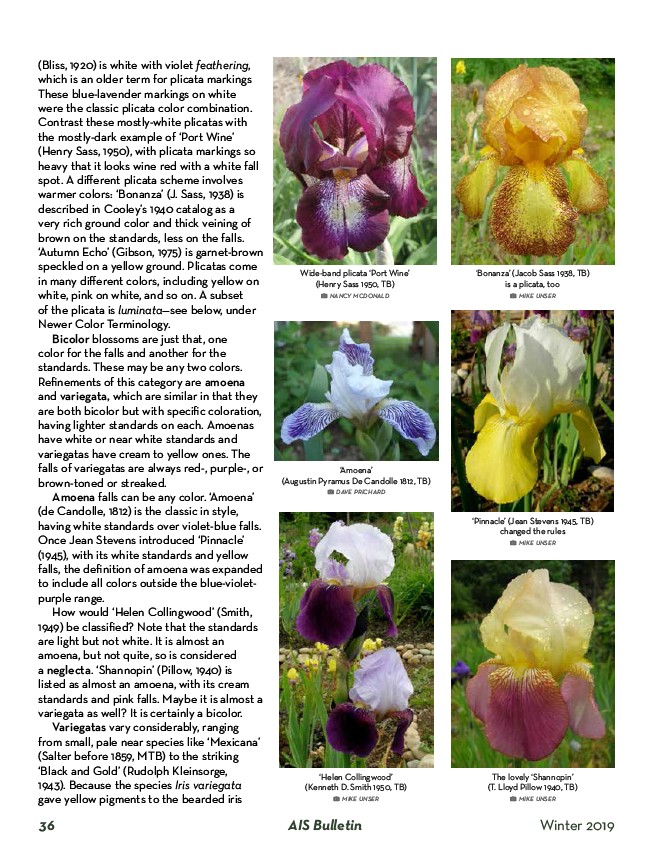
(Bliss, 1920) is white with violet feathering,
which is an older term for plicata markings
These blue-lavender markings on white
were the classic plicata color combination.
Contrast these mostly-white plicatas with
the mostly-dark example of ‘Port Wine’
(Henry Sass, 1950), with plicata markings so
heavy that it looks wine red with a white fall
spot. A different plicata scheme involves
warmer colors: ‘Bonanza’ (J. Sass, 1938) is
described in Cooley’s 1940 catalog as a
very rich ground color and thick veining of
brown on the standards, less on the falls.
‘Autumn Echo’ (Gibson, 1975) is garnet-brown
speckled on a yellow ground. Plicatas come
in many different colors, including yellow on
white, pink on white, and so on. A subset
of the plicata is luminata—see below, under
Newer Color Terminology.
Bicolor blossoms are just that, one
color for the falls and another for the
standards. These may be any two colors.
Refinements of this category are amoena
and variegata, which are similar in that they
are both bicolor but with specific coloration,
having lighter standards on each. Amoenas
have white or near white standards and
variegatas have cream to yellow ones. The
falls of variegatas are always red-, purple-, or
brown-toned or streaked.
Amoena falls can be any color. ‘Amoena’
(de Candolle, 1812) is the classic in style,
having white standards over violet-blue falls.
Once Jean Stevens introduced ‘Pinnacle’
(1945), with its white standards and yellow
falls, the definition of amoena was expanded
to include all colors outside the blue-violetpurple
range.
How would ‘Helen Collingwood’ (Smith,
1949) be classified? Note that the standards
are light but not white. It is almost an
amoena, but not quite, so is considered
a neglecta. ‘Shannopin’ (Pillow, 1940) is
listed as almost an amoena, with its cream
standards and pink falls. Maybe it is almost a
variegata as well? It is certainly a bicolor.
Variegatas vary considerably, ranging
from small, pale near species like ‘Mexicana’
(Salter before 1859, MTB) to the striking
‘Black and Gold’ (Rudolph Kleinsorge,
1943). Because the species Iris variegata
gave yellow pigments to the bearded iris
Wide-band plicata ‘Port Wine’
(Henry Sass 1950, TB)
, nancy mcdonald
‘Bonanza’ (Jacob Sass 1938, TB)
is a plicata, too
, mike unser
‘Amoena’
(Augustin Pyramus De Candolle 1812, TB)
, dave prichard
‘Pinnacle’ (Jean Stevens 1945, TB)
changed the rules
, mike unser
The lovely ‘Shannopin’
(T. Lloyd Pillow 1940, TB)
, mike unser
‘Helen Collingwood’
(Kenneth D. Smith 1950, TB)
, mike unser
36 AIS Bulletin Winter 2019